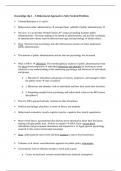Samenvatting
Government and Behaviour: Course Summary (USG4660)
- Instelling
- Universiteit Utrecht (UU)
Ace Your Exam with This Course Summary: Government and Behaviour (USG4660) Looking to ace your exam in Government and Behaviour: The Use of Behavioural Insights in and by Governments (USG4660)? This comprehensive and structured summary is designed to help you master the key concepts quickly and ...
[Meer zien]




